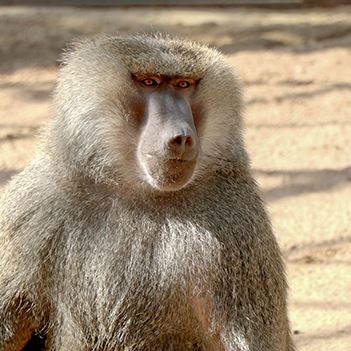Names
بابون زیتونی :Persian name
بابون الزيتوني :Arabic name
English name: Olive Baboon
Scientific name: Papio anubis
General Classification
Phylum: Chordata
Class: Mammalia
Order: Primates
Family: Cercopithecidae
Habitat
The Olive Baboon inhabits steppe and semi-desert regions, including savannas, grasslands, and open woodlands primarily in Africa. Its distribution spans across western and eastern parts of the African continent where it adapts well to various terrestrial habitats
Conservation status
According to the IUCN, the Olive Baboon is classified as Least Concern. Despite this, habitat destruction and localized hunting are threats that require monitoring and conservation efforts
Diet
This species is omnivorous, feeding mostly on soft plants, leaves, fruits, seeds, and occasionally small insects or other animals
Threats
Predators include leopards, caracals, hunting dogs, hyenas, jackals, and humans. Habitat destruction and illegal hunting are major concerns for population stability
Gestation period: 5 to 6 months
Number of offspring: Usually 1 to 2 babies
Age of maturity: About 3 to 4 years
Lifespan: About 20 years
Body length: 90 to 115 cm
Height: 70 to 80 cm
Body weight: 20 to 45 kg
Interesting facts
Olive Baboons are highly social animals living in large troops. They are known for their intelligence and complex communication using vocalizations and body language
Introduction
The Olive Baboon is a common and widespread Old World monkey species native to diverse regions of Africa. These primates live in large, multi-male and multi-female groups exhibiting intricate social behaviors including grooming and vocal interactions. They are primarily herbivorous but opportunistically consume insects and small animals
Their habitat primarily includes savannas, grasslands, and open woodlands. Habitat loss and hunting have pressured populations, but they remain adaptable and resilient in their environments
Olive Baboons display notable intelligence and social complexity, making them pivotal subjects for research into primate behavior and communication systems in the wild

